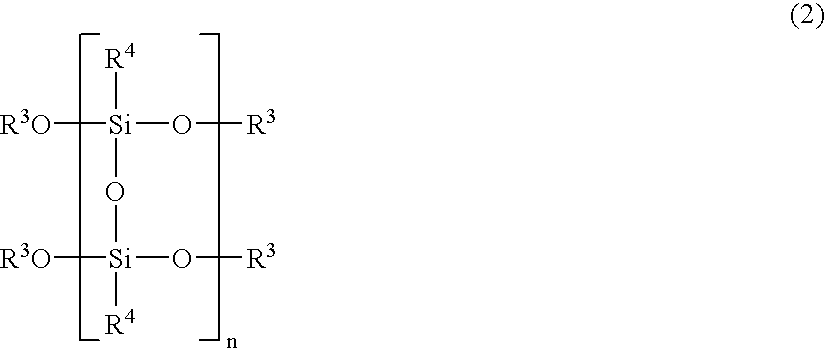Radiation sensitive refractive index changing composition and refractive index changing method
a technology of refractive index and composition, applied in the direction of photosensitive materials, instruments, photomechanical equipment, etc., can solve the problems of deterioration of materials, difficulty in providing a wider refractive index distribution,
- Summary
- Abstract
- Description
- Claims
- Application Information
AI Technical Summary
Benefits of technology
Problems solved by technology
Method used
Image
Examples
synthesis example 1
15.22 g of tetramethoxysilane and 27.24 g of methyltrimethoxysilane were dissolved in 100 g of ethylene glycol ethyl methyl ether in a 1-liter three-necked flask and the obtained mixed solution was heated at 60.degree. C. under agitation with a magnetic stirrer. 5.20 g of ion exchange water was continuously added to the mixed solution in 1 hour. After 4 hours of a reaction at 60.degree. C., the obtained reaction solution was cooled to room temperature. Thereafter, 9.20 g of methanol which was a reaction by-product was distilled off under reduced pressure from the reaction solution. The solid content of the solution of the obtained polymer (B-1) was 33.2% and the weight average molecular weight of the polymer was 2,200.
synthesis example 2
After the inside of a 1.5-liter stainless steel autoclave equipped with an electromagnetic stirrer was fully substituted by nitrogen gas, 500 g of ethyl acetate, 57.2 g of ethyl vinyl ether (EVE), 10.2 g of hydroxybutyl vinyl ether (HBVE) and 3 g of lauroyl peroxide were fed to the autoclave and cooled to -50.degree. C. with dry ice and methanol, and oxygen within the system was removed with nitrogen gas again. 146 g of hexafluoropropylene (HFP) was then fed and the temperature began to be elevated. The pressure when the inside temperature of the autoclave reached 60.degree. C. was 5.3 kgf / cm.sup.2. Thereafter, the reaction was continued at 60.degree. C. for 20 hours under agitation and the autoclave was cooled with water when the pressure dropped to 1.5 kgf / cm.sup.2 to stop the reaction. After the temperature reached room temperature, unreacted monomers were discharged and the autoclave was opened to obtain a polymer solution having a solid content of 28.1%. The obtained polymer so...
synthesis example 3
8 g of 2,2'-azobis(2,4-dimethylvaleronitrile) and 200 g of diethylene glycol dimethyl ether were fed to a 500-ml three-necked flask. Subsequently, 20 g of methacrylic acid, 30 g of glycidyl methacrylate and 50 g of pentafluoroethyl methacrylate were fed to the flask, the inside of the flask was substituted with nitrogen, and stirring was started gently. The temperature of the solution was elevated to 70.degree. C. and maintained at that temperature for 3 hours to obtain a solution of a polymer (B-3). The solid content of the obtained polymer solution was 31.0% and the weight average molecular weight of the polymer was 12,000.
PUM
| Property | Measurement | Unit |
|---|---|---|
| refractive index | aaaaa | aaaaa |
| refractive index distribution | aaaaa | aaaaa |
| boiling point | aaaaa | aaaaa |
Abstract
Description
Claims
Application Information
 Login to View More
Login to View More - R&D
- Intellectual Property
- Life Sciences
- Materials
- Tech Scout
- Unparalleled Data Quality
- Higher Quality Content
- 60% Fewer Hallucinations
Browse by: Latest US Patents, China's latest patents, Technical Efficacy Thesaurus, Application Domain, Technology Topic, Popular Technical Reports.
© 2025 PatSnap. All rights reserved.Legal|Privacy policy|Modern Slavery Act Transparency Statement|Sitemap|About US| Contact US: help@patsnap.com



